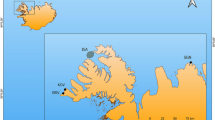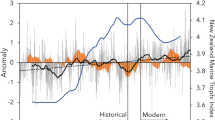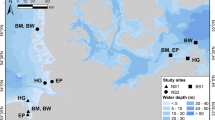Abstract
Overfishing is a worldwide occurrence that simplifies marine food webs, changes trophic patterns, and alters community structure, affecting not only the density of harvested species but also their trophic function. The northwestern Atlantic has a history of heavy fishing, and over the past century has also experienced destructive bottom fishing and harmful mobile fishing gear. After confirming that preservation solvent did not alter the nitrogen stable isotopes of preserved samples, we used museum specimens and modern samples to analyze nitrogen stable isotopes in tissues of two common demersal fishes pre-1950 (1850 to 1950) compared to 2021 to assess changes in trophic positions of coastal New England consumers over this time period. Both the mesopredator Centropristis striata (black sea bass) and the benthivore Stenotomus chrysops (scup) experienced significant declines in trophic position during this time. C. striata declined almost a full trophic level, S. chrysops declined half a trophic level, and these species are now occupying almost the same trophic position. Heavy fishing activities potentially shorten food chains, simplify trophic complexity, lessen the separation of trophic niches, and generally flatten food webs. The consequences of these within-species shifts are poorly investigated but could generate underappreciated cascading impacts on community structure and function. Archived natural-history collections are an invaluable resource for investigating ecological changes in natural communities through time. The evaluation of changing trophic positions via stable isotope analysis may allow fisheries managers to quantify large-scale effects of fishing on ecosystems and food webs over time.




Similar content being viewed by others
Data availability
All stable isotope data are stored in the Smithsonian Museum Conservation Institute SIDora archive and is available upon public request.
Code availability
The RStudio code used during the current study is available from the corresponding author on request.
References
Arrington DA, Winemiller KO (2002) Preservation effects on stable isotope analysis of fish muscle. Trans of the Am Fish Soc 131:337–342
Asch RG, Collie JS (2008) Changes in a benthic megafaunal community due to disturbance from bottom fishing and the establishment of a fishery closure. Fish Bull 106:438–456
Baumgartner LJ (2007) Diet and feeding habits of predatory fishes upstream and downstream of a low-level weir. J of Fish Biol 70:879–894
Becker BH, Beissinger SR (2006) Centennial decline in the trophic level of an endangered seabird after fisheries decline. Conserv Biol 20:470–479
Blanke C, Chikaraishi Y, Vander Zanden MJ (2018) Historical niche partitioning and long-term trophic shifts in Laurentian Great Lakes deepwater coregonines. Ecosphere 9:e02080. https://doi.org/10.1002/ecs2.2080
Boonstra WJ, Österblom H (2014) A chain of fools: or, why it is so hard to stop overfishing. Marit Stud. https://doi.org/10.1186/s40152-014-0015-4
Byron C, Link J (2010) Stability in the feeding ecology of four demersal fish predators in the US Northeast Shelf Large Marine Ecosystem. Mar Ecol Prog Ser 406:239–250
Carassou L, Kulbicki M, Nicola TJR, Polunin NVC (2008) Assessment of fish trophic status and relationships by stable isotope data in the coral reef lagoon of New Caledonia, southwest Pacific. Aq Living Resour 21:1–12
Carballeira C, Viana IG, Carballeira A (2013) δ15N values of macroalgae as an indicator of the potential presence of waste disposal from land-based marine fish farms. J of Appl Phycol 25:97–107
Collie J (2000) Photographic evaluation of the impacts of bottom fishing on benthic epifauna. ICES J of Mar Sci 57:987–1001
Collie J, Escanero G, Valentine P (1997) Effects of bottom fishing on the benthic megafauna of Georges Bank. Mar Ecol Prog Ser 155:159–172
Collie JS, Hall SJ, Kaiser MJ, Poiner IR (2000) A quantitative analysis of fishing impacts on shelf-sea benthos: Effects of fishing on benthos. J of Anim Ecol 69:785–798
Collie J, Hiddink JG, van Kooten T, Rijnsdorp AD, Kaiser MJ, Jennings S, Hilborn R (2017) Indirect effects of bottom fishing on the productivity of marine fish. Fish and Fish 18:619–637
Dell C, Montoya J, Hay M (2015) Effect of marine protected areas (MPAs) on consumer diet: MPA fish feed higher in the food chain. Mar Ecol Prog Ser 540:227–234
Dudley BD, Shima JS (2010) Algal and invertebrate bioindicators detect sewage effluent along the coast of Titahi Bay, Wellington, New Zealand. N. Z. J of Mar and Freshw Res 44:39–51
English PA, Green DJ, Nocera JJ (2018) Stable isotopes from museum specimens may provide evidence of long-term change in the trophic ecology of a migratory aerial insectivore. Front Ecol and Evol. https://doi.org/10.3389/fevo.2018.00014
Estes JA, Terborgh J, Brashares JS, Power ME, Berger J, Bond WJ, Carpenter SR, Essington TE, Holt RD, Jackson JB (2011) Trophic downgrading of planet Earth. Science 333:301–306
Gagne T, Hyrenbach KD, Hagemann M, Bass O, Pimm S, Peck B, Houtan KV (2018a) Seabird trophic position across three ocean regions tracks ecosystem differences. Front Mar Sci. https://doi.org/10.3389/fmars.2018.00317
Gagne TO, Hyrenbach KD, Hagemann ME, Van Houtan KS (2018b) Trophic signatures of seabirds suggest shifts in oceanic ecosystems. Sci Adv 4:aao3946. https://doi.org/10.1126/sciadv.aao3946
Gannes LZ, O’Brien DM (1997) Stable isotopes in animal ecology: assumptions, caveats, and a call for more laboratory experiments. Ecology 78(4):1271–1276
Garrison L, Link J (2000) Dietary guild structure of the fish community in the Northeast United States continental shelf ecosystem. Mar Ecol Prog Ser 202:231–240
Gaston TF, Kostoglidis A, Suthers IM (2004) The 13C, 15N and 34S signatures of a rocky reef planktivorous fish indicate different coastal discharges of sewage. Mar Freshw Res 55:689–699
González-Bergonzoni I, Vidal N, Wang B, Ning D, Liu Z, Jeppesen E, Meerhoff M (2015) General validation of formalin-preserved fish samples in food web studies using stable isotopes. Methods in Ecol and Evol 6:307–314
Hempson TN, Graham NAJ, MacNeil MA, Williamson DH, Jones GP, Almany GR (2017) Coral reef mesopredators switch prey, shortening food chains, in response to habitat degradation. Ecol and Evol 7:2626–2635
Hempson TN, Graham NAJ, MacNeil MA, Bodin N, Wilson SK (2018) Regime shifts shorten food chains for mesopredators with potential sublethal effects. Funct Ecol 32:820–830
Hermsen J, Collie J, Valentine P (2003) Mobile fishing gear reduces benthic megafaunal production on Georges Bank. Mar Ecol Prog Ser 260:97–108
Hiddink JG, Johnson AF, Kingham R, Hinz H (2011) Could our fisheries be more productive? Indirect negative effects of bottom trawl fisheries on fish condition: effects of bottom trawls on fish condition. J of Appl Ecol 48:1441–1449
Jackson JBC, Kirby MX, Berger WH, Bjorndal KA, Botsford LW, Bourque BJ, Bradbury RH, Cooke R, Erlandson J, Estes JA, Hughes TP, Kidwell S, Lange CB, Lenihan HS, Pandolfi JM, Peterson CH, Steneck RS, Tegner MJ, Warner RW (2001) Historical overfishing and the recent collapse of coastal ecosystems. Science 293:629–637
Johnson S, Domínguez-García V, Donetti L, Muñoz MA (2014) Trophic coherence determines food-web stability. Proc Nat Acad of Sci 111:17923–17928
Johnson AF, Gorelli G, Jenkins SR, Hiddink JG, Hinz H (2015) Effects of bottom trawling on fish foraging and feeding. Proc Royal Soc B. https://doi.org/10.1098/rspb.2014.2336
Kaiser MJ, Ramsay K, Richardson CA, Spence FE, Brand AR (2000) Chronic fishing disturbance has changed shelf sea benthic community structure. J of Anim Ecol 69:494–503
Lapointe BE, Tewfik A, Phillips M (2021) Macroalgae reveal nitrogen enrichment and elevated N: P ratios on the Belize Barrier Reef. Mar Pollut Bull 171:112686. https://doi.org/10.1016/j.marpolbul.2021.112686
Lloret J, Demestre M, Sánchez-Pardo J (2007) Lipid reserves of red mullet (Mullus barbatus) during pre-spawning in the northwestern Mediterranean. Sci Mar 71:269–277
Madin EMP, Gaines SD, Madin JS, Warner RR (2010) Fishing indirectly structures macroalgal assemblages by altering herbivore behavior. The Amer Nat 176:785–801
Moser J, Shepherd GR (2009) Seasonal distribution and movement of black sea bass (Centropristis striata) in the Northwest Atlantic as determined from a mark-recapture experiment. J of Northwest Atl Fish Sci 40:17–28
Musick JA, Mercer LP (1977) Seasonal distribution of black sea bass, Centropristis striata, in the Mid-Atlantic Bight with comments on the ecology and fisheries of the species. Trans Am Fish Soc 106:12–25
Myers RA, Baum JK, Shepherd TD, Powers SP, Peterson CH (2007) Cascading effects of the loss of apex predatory sharks from a coastal ocean. Science 315:1846–1850
NOAA Northeast Fisheries Science Center (2022) A brief history of the groundfishing industry of New England. www.fisheries.noaa.gov.
Ogawa NO, Chikaraishi Y, Ohkouchi N (2013) Trophic position estimates of formalin-fixed samples with nitrogen isotopic compositions of amino acids: an application to gobiid fish (Isaza) in Lake Biwa. Japan Ecol Res 28:697–702
Ostrom PH, Wiley AE, James HF, Rossman S, Walker WA, Zipkin EF, Chikaraishi Y (2017) Broad-scale trophic shift in the pelagic North Pacific revealed by an oceanic seabird. Proc Royal Soc B. https://doi.org/10.1098/rspb.2016.2436
Post DM (2002) Using stable isotopes to estimate trophic position: models, methods, and assumptions. Ecology 83:703–718
Post DM, Pace ML, Hairston NG (2000) Ecosystem size determines food-chain length in lakes. Nature 405:1047–1049
Power ME, Tilman D, Estes JA, Menge BA, Bond WJ, Mills LS, Daily G, Castilla JC, Lubchenco J, Paine RT (1996) Challenges in the quest for keystones. Bioscience 46:609–620
Rasher DB, Hoey AS, Hay ME (2017) Cascading predator effects in a Fijian coral reef ecosystem. Sci Rep 7:15684. https://doi.org/10.1038/s41598-017-15679-w
Sanderson BL, Train CD, Coe HJ, Pelekis V, Steel EA, Reichert WL (2009) Nonlethal sampling of fish caudal fins yields valuable stable isotope data for threatened and endangered fishes. Trans of the Am Fish Soc 138:1166–1177
Schimmelmann AA, Albertino A, Sauer PE, Qi H, Molinie R, Mesnard F (2009) Nicotine, acetanilide and urea multi-level 2H, 13C, and 15N-abundance reference materials for continuous flow isotope ratio mass spectrometry. Rapid Commun Mass Spectrom 23:3513–3521
Shepherd GR, Terceiro M (1994) The summer flounder, scup, and black sea bass fishery of the Middle Atlantic Bight and southern New England waters. NOAA Tech Rep NMFS 122
Slesinger E, Jensen OP, Saba G (2021) Spawning phenology of a rapidly shifting marine fish species throughout its range. ICES J of Mar Sci 78:1010–1022
Slesinger E, Bates K, Wuenschel M, Saba GK (2022) Regional differences in energy allocation of black sea bass (Centropristis striata) along the US Northeast Shelf (36°N to 42°N) and throughout the spawning season. J of Fish Biol 100:918–934
Smith B, Collie J, Lengyel N (2013) Effects of chronic bottom fishing on the benthic epifauna and diets of demersal fishes on northern Georges Bank. Mar Ecol Prog Ser 472:199–217
Smith JA, Thomas AC, Levi T, Wang Y, Wilmers CC (2018) Human activity reduces niche partitioning among three widespread mesocarnivores. Oikos 127:890–901
Stallings CD (2008) Indirect effects of an exploited predator on recruitment of coral reef fishes. Ecology 89:2090–2095
Stallings C (2009) Predator identity and recruitment of coral-reef fishes: indirect effects of fishing. Mar Ecol Prog Ser 383:251–259
Steimle FW, Zetlin CA, Berrien PL, Johnson DL, Chang S (1999) Black Sea Bass, Centropristis striata, life history and habitat characteristics. NOAA Tech Memo NMFS-NE 143:1–42
Steimle FW, Zetlin CA, Berrien PL, Johnson DL, Chang S (1999) Scup, Stenotomus chrysops, life history and habitat characteristics. NOAA Tech Memo NMFS-NE 149:1–39
Steneck RS, Pauly D (2019) Fishing through the Anthropocene. Curr Biol 29:R942–R995
Steneck RS, Vavrinec J, Leland AV (2004) Accelerating trophic-level dysfunction in kelp forest ecosystems of the western North Atlantic. Ecosystems 7:323–332
Suzuki KW, Kasai A, Nakayama K, Tanaka M (2005) Differential isotopic enrichment and half-life among tissues in Japanese temperate bass (Lateolabrax japonicus) juveniles: implications for analyzing migration. Can J of Fish and Aq Sci 62:671–678
Suzzi AL, Gaston TF, McKenzie L, Mazumder D, Huggett MJ (2022) Tracking the impacts of nutrient inputs on estuary ecosystem function. Sci Total Env 811:152405. https://doi.org/10.1016/j.scitotenv.2021.152405
Valiela I, Foreman K, LaMontagne M, Hersh D, Costa J, Peckol P, DeMeo-Anderson B, D’Avanzo C, Babione M, Sham CH, Brawley J, Lajtha K (1992) Couplings of watersheds and coastal waters: sources and consequences of nutrient enrichment in Waquoit Bay, Massachusetts. Estuaries 15:443–457
Watling L, Norse EA (1998) Disturbance of the seabed by mobile fishing gear: a comparison to forest clearcutting. Conserv Biol 12:1180–1197
Willert MS, France CAM, Brooks BL, Baldwin CC, Hay ME (2020) Effects of formalin preservation on carbon and nitrogen stable isotopes of seaweeds: a foundation for looking back in time. Limnol and Oceanogr Methods 18:717–724. https://doi.org/10.1002/lom3.10397
Willis T, Wilson K, Alexander K, Leavenworth W (2013) Tracking cod diet preference over a century in the northern Gulf of Maine: historic data and modern analysis. Mar Ecol Prog Ser 474:263–276
Witman JD, Sebens KP (1992) Regional variation in fish predation intensity: a historical perspective in the Gulf of Maine. Oecologia 90:305–315
Worm B, Barbier EB, Beaumont N, Duffy JE, Folke C, Halpern BS, Jackson JBC, Lotze HK, Micheli F, Palumbi SR, Sala E, Selkoe KA, Stachowicz JJ, Watson R (2006) Impacts of biodiversity loss on ocean ecosystem services. Science 314:787–790
Acknowledgements
We thank the anonymous reviewers and the handling editor whose constructive comments improved our manuscript. We gratefully acknowledge the support of the Smithsonian Institution Peter Buck Fellowship, the Anna and Harry Teasley Gift Fund to the Georgia Institute of Technology, and Smithsonian Museum Conservation Institute Federal and Trust Funds.
Funding
This study was funded by the Smithsonian Institution Peter Buck Fellowship to MSW, the Anna and Harry Teasley Gift Fund to the Georgia Institute of Technology, and Smithsonian Museum Conservation Institute Federal and Trust Funds.
Author information
Authors and Affiliations
Contributions
MSW conceived and designed the experiments, analyzed the data, and wrote the manuscript. MSW and CAMF collected the data. CAMF, CCB, and MEH provided crucial research and editorial advice throughout the process.
Corresponding author
Ethics declarations
Conflict of interest
The named authors have no conflicts of interest, financial or otherwise.
Ethical approval
Ethics approval was waived by the Georgia Institute of Technology’s Office of Research Integrity Assurance, because all animals were independently caught by fishermen and already deceased prior to sampling.
Consent to participate
Not applicable.
Consent for publication
All authors consent to publication of this study.
Additional information
Communicated by Joel Trexler.
Rights and permissions
Springer Nature or its licensor (e.g. a society or other partner) holds exclusive rights to this article under a publishing agreement with the author(s) or other rightsholder(s); author self-archiving of the accepted manuscript version of this article is solely governed by the terms of such publishing agreement and applicable law.
About this article
Cite this article
Willert, M.S., France, C.A.M., Baldwin, C.C. et al. Historic trophic decline in New England’s coastal marine ecosystem. Oecologia 202, 455–463 (2023). https://doi.org/10.1007/s00442-023-05410-0
Received:
Accepted:
Published:
Issue Date:
DOI: https://doi.org/10.1007/s00442-023-05410-0




